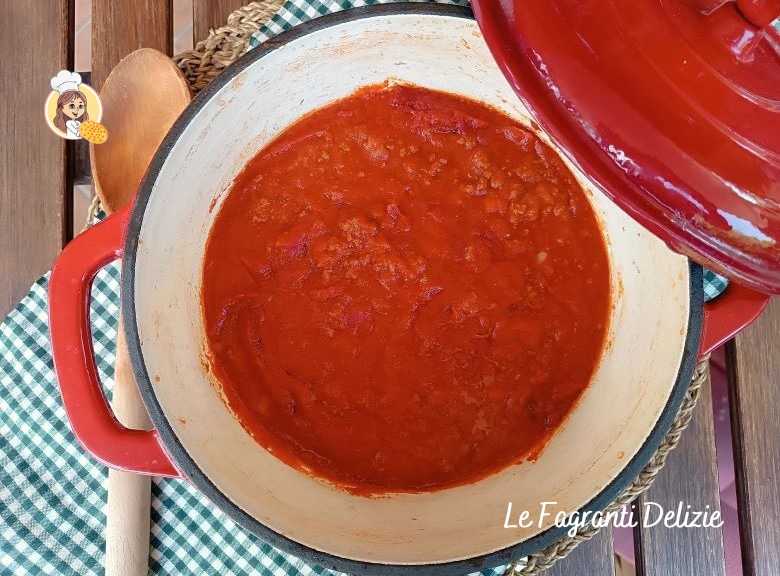There is something deeply comforting when I prepare a good Bolognese Ragù. The aroma that spreads in the kitchen brings to mind family Sundays, with the warmth of my grandmother’s fireplace and the sound of laughter and conversations filling the air. Every spoonful of this rich and flavorful sauce is a warm hug, a dive back to years gone by and those special moments spent around the table with my grandparents and my father who are no longer with us. In other words, people dear to me. Preparing Bolognese ragù, for me, is not just cooking, but it’s a ritual rich in love and tradition, a way to evoke the past and create new memories.
But now I’m pleased to tell you a bit of history, which you probably already know, about this timeless condiment known and used all over the world. Bolognese ragù is one of the symbols of Italian cuisine, particularly of the Emilia culinary tradition. Although this sauce dates back several centuries, particularly to the Middle Ages, the first written recipe dates back to the late 18th century, thanks to Pellegrino Artusi who described it in his famous book “Science in the Kitchen and the Art of Eating Well” of 1891. Artusi used veal, pancetta, butter, carrot, onion, and tomato sauce, with long and slow cooking. Currently, the new recipe filed at the Bologna Chamber of Commerce does not include veal pulp but beef and instead of butter as fat, extra virgin olive oil is used.
This delicious ragù is ideal for dressing excellent homemade tagliatelle, lasagna, and why not, even a good risotto!
Follow me on my socials, Facebook by clicking HERE or on Instagram (HERE) and you won’t miss any recipes. Go back to the HOME PAGE
Are you looking for a tasty first course? Check out these recipes!

- Cost: Medium
- Preparation time: 10 Minutes
- Portions: 4
- Cooking methods: Slow Cooking, Stove
- Cuisine: Italian
- Seasonality: All Seasons
Ingredients
Here’s what you need to prepare the Bolognese Ragù
- 14 oz ground beef
- 1/2 white onion
- 1 carrot
- 1 stalk celery
- 7 oz tomato purée
- 1 tablespoon tomato paste
- 1 glass white wine (or red)
- 1 cup vegetable broth (or water)
- 3 tablespoons extra virgin olive oil
- 1 teaspoon salt
- 4 cups water
- 3.5 oz carrots
- 2.5 oz tomatoes
- 2.5 oz celery
- 3.5 oz yellow onion
- 1 to taste salt
Tools
To prepare the ragù, I usually use the earthenware pot and I won’t tell you how flavorful… but unfortunately, it broke and this time I used the cast iron pot. Result? The ragù turned out amazing.
Procedure
To make the Bolognese ragù, first prepare the vegetable broth. Clean the vegetables (carrots, celery, tomatoes, onion) and chop them into pieces. Place them in a pot and cover with a liter of water. Turn on the heat and bring to a boil, then cover with a lid and let it simmer for about an hour (lowering the heat). At the end of cooking, strain the broth and set aside. In the meantime, handle the vegetables. Peel the carrot and finely chop it [1]. Then clean the celery and chop it to the same size (sorry, I forgot to take the photo 😅). Do the same with the onion [2]. In a preheated saucepan, pour the oil and add the chopped vegetables [3].

Stir and let them stew for 5-6 minutes over low heat [4]. Add the minced beef to the sauté. Stir and raise the heat a bit. Let it brown, and when the meat is nicely browned [5], deglaze with the wine. As soon as the alcohol evaporates, add the tomato paste and purée [6]. Stir well to incorporate everything. Add a couple of ladles of hot vegetable broth or water. Cover and let it cook for at least a couple of hours (at this stage, taste and adjust the salt), taking care to stir the ragù from time to time.

Stir everything well and your ragù is ready to dress tagliatelle, lasagna, homemade maltagliati, or with potato gnocchi which are a must on Sundays in Naples.


